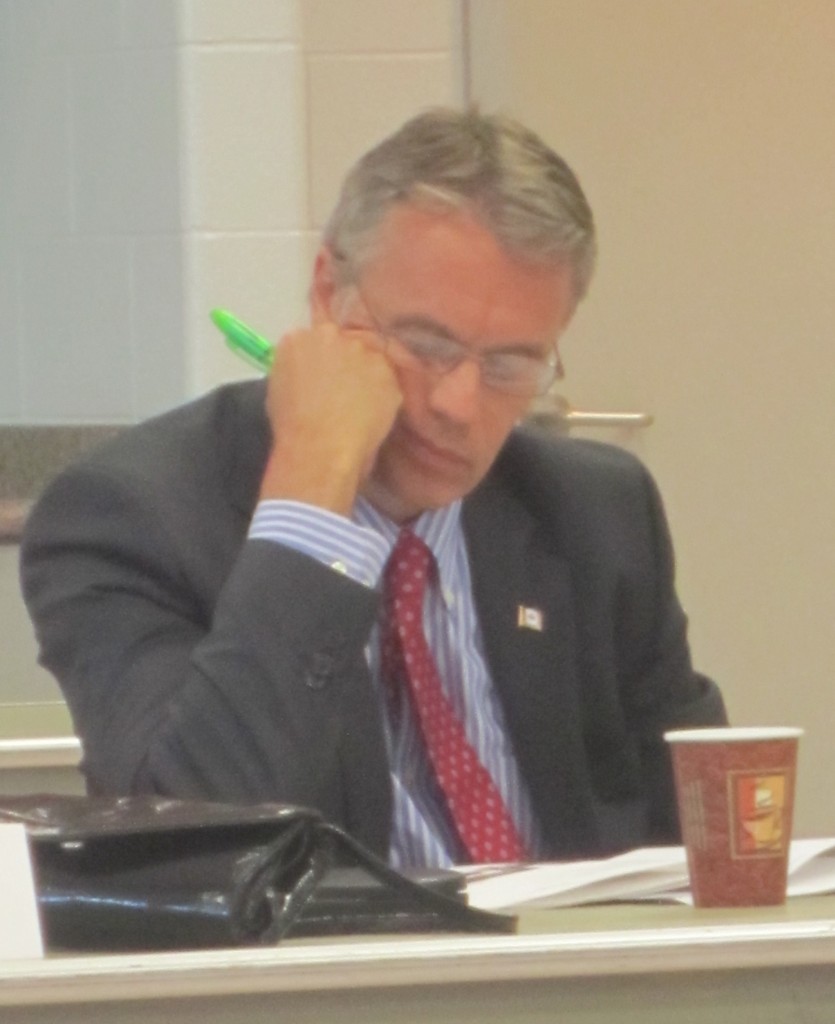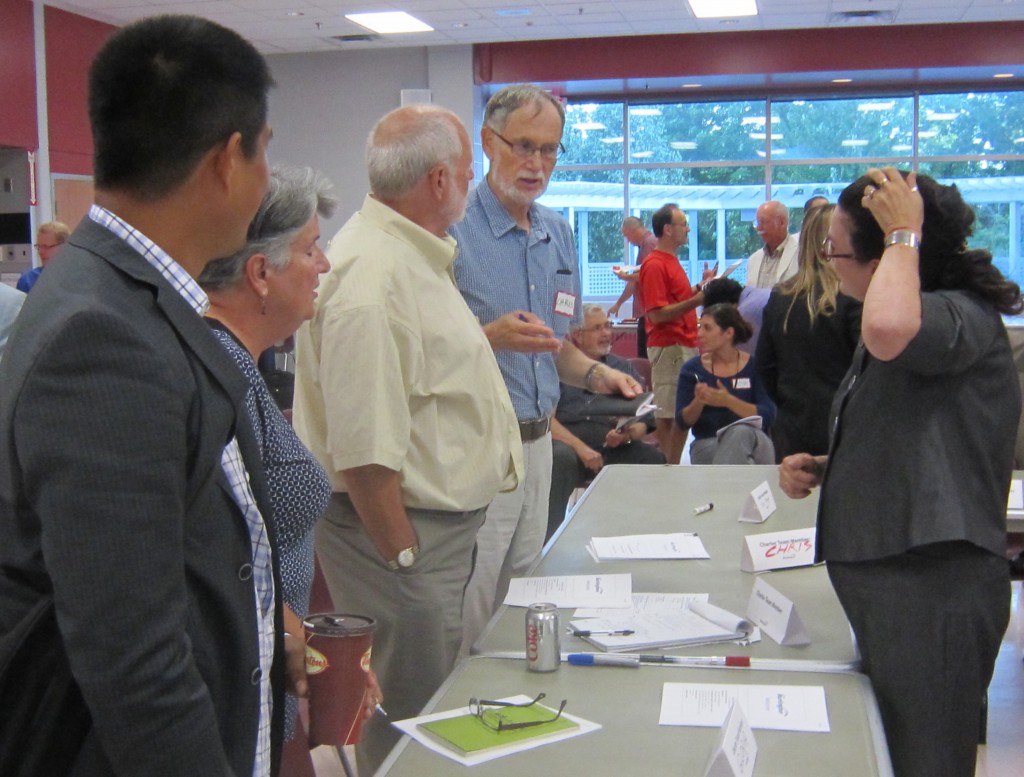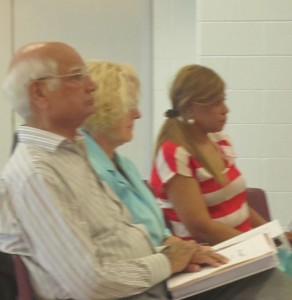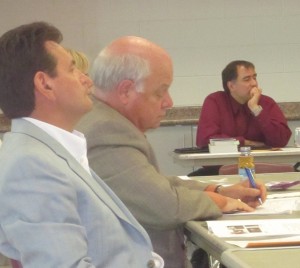BURLINGTON, ON July 2nd, 2012 The city got its first look at what the people behind the creation of a Community Engagement Charter (CEC) are thinking. We saw a rough structure that spokesperson Chris Walker called “bones with no meat on it yet”.
The meeting was part of a council Workshop where no one got very excited about the presentation being made. This was the first chance council got to see what the CEC people have been doing for six months. There wasn’t that much to show for their efforts.

The Community Engagement team didn't manage to engage council members at a Council Workshop - once council member didn't ask a single question. They Mayor had difficulty staying focused. The coffee didn't help.
The meeting had a quorum but not much more than that. Councillors Taylor, Lancaster, Craven and Meed Ward were at the table. Councillor Dennison was in the room but not at the table for an event which was held in the community at Tansley Woods. Councillor Sharman didn’t attend. The Mayor was there but – well the picture tells that story.
Community Engagement Coordinator Christine Iamonaco introduced her team, which we learned consisted of 24 active participants; 86 people monitoring Basecamp, which is a web location that posts all the documents and the flow of information used by the Engagement Committee. There were 50 people participating via the Basecamp set up.
That’s a total of less than 100 people who were attached to the team in some way. Clearly Community Engagement hasn’t caught on fire in Burlington. There were more media and politicians than there were public at one of the community meetings in Ward 1.
One can’t blame Iamonaco for the turnout – the idea or belief that the city needed to improve the level of citizen engagement isn’t that wide spread. No one cares – until there is an issue that impacts on them – then we get a turnout that fills an arena meeting room.
Let’s first take a look at what the Community Engagement Charter people want to see changed and then look at how things work in different parts of the city when there is a problem.

Members of the Community Engagement Team do a debrief after their Council Workshop session. Chris Walker is in the center.
They put forward a Vision Statement – these things can be atrocious and are at times just “happy talk” or an ideal that is so far from reality that they aren’t taken as serious. The Community Engagement Charter team put this forward in a vision statement. They saw it as a Big Hairy Audacious Goal to “make Burlington the most engaged and connected community in Canada involving all generations, socio-economic and cultural groups”. No wonder the mayor was yawning.
What does that mean and how do you do that? The Mission Statement, one step beneath the Vision , explained how this would “…provide Burlington citizens, city council and city staff a plain language living document, that promotes active and meaningful citizen engagement in City of Burlington planning, policy-making and decision making processes.” Whew!
The Charter the CEC people want to put in place will work from the Vision through the Mission statement and be truly unique because it will be “created by the community for the community with an implementation plan that aligns with the Strategic Plan, the Official Plan, e-government strategy and “operationalizes” the Community Engagement Charter.” When the Charter is in place it will be reviewed annually for a period of time and then reviewed when the Strategic Plan is given a review.
And at this point I expect I’ve lost whatever readership there was for this story.
How did we get to where we are?
The city spends tens of thousands of dollars every year on advertising – and gets very little in the way of a return. Everyone talks about how e-government is going to change everything for the better when we don’t know yet what the city is planning nor do we know what the community wants.
In his remarks Walker made a very good point on the Workshop setting not being open to any back and forth between the CEC team, the few members of the public in the room and the city council members. It would have been interesting to watch what happened had Walker asked for a change in the format of the meeting and see how the Clerk and the council members reacted.
Everyone in the room had great expectations for “e-government”; a concept that has as many definitions as there are people using the term. Burlington recently brought Brent Stanbury back on staff to get the “e-government” process up and going. Stanbury has been given some direction by Budget and Corporate Services General Manager Kim Phillips but those have not been shared with the CEC team or the public in general.
The Community Engagement Charter team, began by looking at every example of community engagement they could find and produced a three inch binder with page upon page of background material.

Members of the public didn't get a chance to engage the council members on just what they wanted from a Community Engagement Charter.
They came to the conclusion that Burlington’s existing practices are good and there are opportunities for enhancements. That’s not what the Shape Burlington report had to say when it was published. Several of the people on the CEC team were core members of Shape Burlington and it’s offspring Shaping Burlington. The fire would appear to have gone from the belly of the people who were there in the early days – back in April of 2010.
The framework they are working from emphasizes city council commitments and citizen responsibilities. They want to identify existing best practices and include engagement guidance for city staff.
The team has identified commitments city council has made and wants to ensure those commitments are met, which means some form of ongoing monitoring of what happens at city hall. Shaping Burlington has done very little in the way of monitoring what gets done at both committee and council meetings.
Setting out citizen responsibilities is the kind of thing that gets taught at the dinner table. Sort of like the Ten Commandments – I know what they are – maintaining them is my problem. Everyone knows what their civic responsibility is – the first being to vote and with a current 34% range turnout – well we know which direction we want to go in on that one
The Charter that gets produced is going to be a 20 page document- that’s a relief. A Citizens Responsibility Guide is a little presumptuous. Bring Commitments to Life – that’s one that needs to be unpacked.
The Charter Team wants to start with the four commitments the city has already adopted:
citizen involvement;
transparency,
accountability
and adherence to the public engagement continuum as set out in the IAP2 process the city has adopted.
The CEC team want the city to be open to new ideas – bit of a stretch there. Politicians will always say they are open to new ideas – but that’s about it.
Early and broader notification – YES!
Customer service – city hall has some ideas they are working through – but they appear to be doing so in a room by themselves. This is one where the CEC people could have a significant impact.
The Region of Halton has a citizens panel – they call it MVP – My Point of view. Burlington would be well served if it had such a panel – say 150 people selected randomly that they communicated with electronically from time to time. Every year they would renew the panel.
The CEC team could have, and still should, get out and do some polling – get out and ask people what they think and feel – be as interactive as you want the people to be. There is a tinge of the academic to much of what the CEC people are doing. Democracy is a messy, down at the street level business – it is noisy, there is nothing polite about it.

Two of the city councillors were not at the table and one didn't ask a single question. Councillor Craven chose to be mute.
Democracy tries to ensure that everyone’s needs are fairly met and that the rule of law overrides everything. Which is fine – but when your specific needs are being trampled upon (they closed off your street so that bicycles could drive up and down for a couple of hours) then it doesn’t appear all that democratic to you.
Two examples of what the city is doing to improve customer service are telling: There will eventually be a single cash counter. If you are there to pay a parking ticket and then buy a ticket for an event – you now get sent to different counters. Centralizing this will make things much more convenient. Good move.
Disseminating information: – there are some moves here that are troublesome. The city is shoving everything out to their web site – but the web site is not easy to navigate and the search facility is not user friendly. The city has brought back the person who created the internal COBNET used by staff to talk about things you are not supposed to read. This is a level at which the CEC people want to lean very heavily. Civil servants by nature don’t naturally share information. Ask a question and they will ask you why you want the information. That’s just the way they are built – but that doesn’t mean they have to stay that way. This is what Shape Burlington meant by that information deficit.
In their deliberations the CEC people brought forward a definition that I’d forgotten I knew – community capacity, which is the capacity a community has to participate and the level at which a community participates in the growth and development of the community.
As the CEC team puts “meat on the bones” of the framework they have in place one hopes they will see opportunities to set in place ways to increase that community capacity. This isn’t easy stuff to do but there are some pretty bright people within that 24 member active core group.
The CEC report suggested a pilot project to support neighbourhood development; experience shows those approaches don’t work. People will agitate when they are upset. People will organize when leadership appears. Councillor Meed Ward created a community advisory committee that works – they don’t always agree with her but she is open and listens. Craven has been doing it for some time in Ward 1.
Each of the council members has an organized relationship with their communities; some are better at it than others and each brings their personalities and their feel for their communities to this task. The wiser municipal politicians will develop and maintain the strongest possible relationship with their community. It’s the cheapest form of campaigning they are ever going to find and they get paid while they do it.
Meed Ward attached herself to the Save our Waterfront organization and used it to propel herself into office. She made the pier her issue and is closely identified with what happens to that project. In Burlington the level most people participate at is galas and fund raisers. You could be out almost every weekend of the year at some event. This city is very open to helping.
What it isn’t doing all that well is being a real meaningful part of the civic process – and a large part of that is because there has been no one pushing against the edge of the envelope. Burlingtonians just accept that whatever is going on at city hall is OK; that whatever is going on at the hospital is fine when there are very real concerns at city hall – our transit problems, determining what kind of a city we are going to be 10 to 15 years out when we have more seniors that have to be taken care of and we don’t have plans or capacity to take care of them.
And the 90 + people that died at the hospital because the place wasn’t kept clean tells you what was going on over there. Public institutions are a bit like children – they need constant watching. You have to say – “no, don’t do that, please do this, I would prefer that you do that”.
There does come a time when your children get it and don’t have to be watched in quite the same way. Your elected officials and civil servants have to be watched all the time. Not because you can’t trust them – but because they don’t have any of their own skin in the game.
Let me expand on that. The little guy who runs a shop on Brant Street or the car dealership on Fairview pays a lot of attention to the people who walk through their doors – because if those people don’t come back – those business people don’t eat quite as well.
The folks at city hall don’t have to be efficient; there is no incentive to be efficient – they don’t own the business. They will perform well if there is top notch senior level management people in place setting the standard. Burlington has not in the past been blessed with that level of talent at the city manager level.
This city just parted ways with a senior level manager because he wasn’t top notch. Civic administration needs to be groomed and made professional; doing that calls for a leadership that demands professionalism. A bylaw report got sent back recently to be “cleaned up” because it wasn’t good enough. That has to happen more often.
A city manager will catch those things and if he or she is doing their job – there will be phone calls made. In Burlington – if you work at city hall and you are doing your job – you get a little note from Jeff Fielding the city manager saying thank you. If you work at city hall and you don’t get a note during the year – you might ask yourself if you are as professional as you should be.
The Check List idea was a good one. The community could create a check list and then monitor the city’s progress and put the tick marks in the boxes and have them posted in a public place. (This is something Our Burlington will look into – we just might be able to do that.)
Early successes – here they were into stretching it mode. The Mayor speaking at an Innovations in Public Consultation and Engagement conference can’t be described as an “early” win. Describing Burlington as a recognized engagement leader is self-serving at best.
This city is still stuck at describing ourselves at Canada’s # 2 Best city to live in. Folks – that survey was a magazine circulation building exercise – something the people at Economic Development missed when they featured the #2 standing in a full page, full colour advertisement in a respected business.
The 26 people actively participating in the development of an Engagement Charter is just not a very impressive number and makes it hard to claim that there is large community involvement in this endeavour. That is not meant to diminish or dismiss the work being done – but let’s be frank with what the CEC team has managed to get done in six months.
How does a community express it concerns? How does a community take an active part in its development and growth? The first step is having a public that knows what it is talking about and that means keeping them informed.
And that basically was what the Shape Burlington report was all about. It said the city had an “information deficit” and that people didn’t know what was going on and that city hall made a lot of decisions without asking the public what they thought or felt.
The CEC team now takes the framework to the community. They have some plans for an innovative approach to talking to the public on the downtown car free Sunday, July 15th. They should certainly have a good crowd to work with.
More community engagement in September and then taking the Charter to the public for review in October. In December it becomes a report to city council where the CEC would like to see the document approved as city policy and procedure.
Funding is always important: will the city commit real long term dollars to community engagement or will the final report the CEC people submit get the “receive and file” that this interim report got?
Don’t expect city hall to lead a review of whatever comes out of this process – it will be up to the community to push for what they want – that’s a lot of work for 26 people to do. It has been done before however.




















